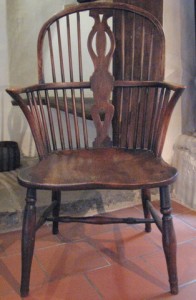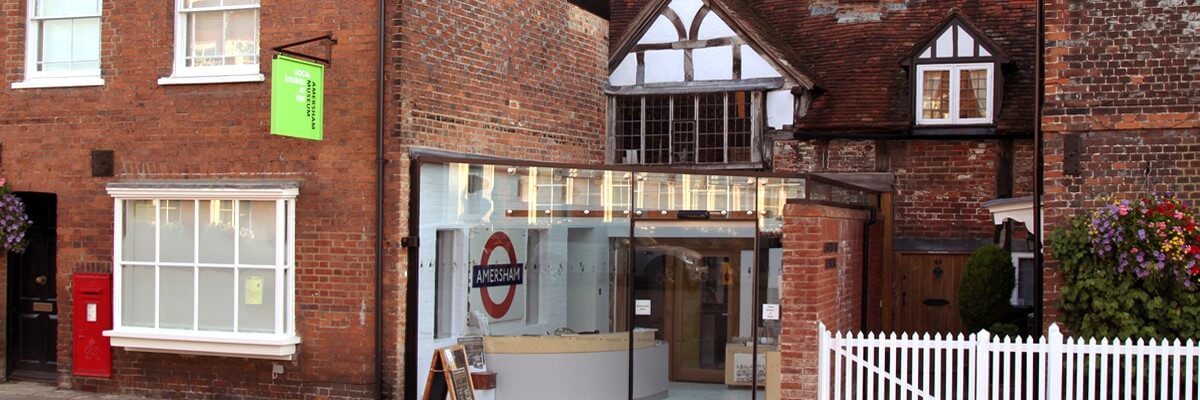
This account of a talk given in 2011 by Dr Catherine Grigg was written by Dorothy Symes and first appeared on the Amersham Society website
Amersham Society members were treated to a lively and well illustrated talk by Dr. Grigg about one of the traditional Chiltern industries. Dr. Grigg, whose doctorate is in Furniture History, is curator of Wycombe Museum.
Dr. Grigg started her talk by describing the basic features of Windsor Chairs, which are traditional to the Chiltern area but are also made in other parts of the country. They were probably first made in the 18thcentury. The working definition of a Windsor Chair is “a stool with an added back” which it is possible to take off. Wheelwrights would make the backs, which slotted in to the top of the stool. Originally wheelwrights made the whole chair – later specialist chairmakers.
The description “Windsor Chair” relates to the construction method not the design. There are infinite possible designs such as the scroll back, the wheel back, the comb back, the bow back with or without arms, and with or without a central splat down the back. In the Chilterns it was rare not to have a splat.
Dr. Grigg illustrated her talk with photographs and asked members from time to time to identify which was a picture of a Windsor Chair and which was of a different construction. Members usually came up with the right answer! One of the photographs was of a primitive Welsh three legged Windsor Chair made in the late 19thcentury. Other chairs made in the 18thand 20thcenturies sometimes had cabriole legs, H – form stretchers and crinoline stretchers.
The origin of the Windsor Chair is said to be based on a time when George III was caught in a rainstorm in Windsor Great Park. He sheltered in a nearby cottage and was offered the most comfortable chair. There is no evidence that it was subsequently used in Windsor Castle. The chairs were probably made near Windsor and were transported by boat to both Windsor and London. They were usually made from ash and beech with an elm seat but could also be made from yew.
The legs of the Chiltern Windsor chairs were slender, while those made in the Midlands were more bulbous. Those from the Midlands had a splat made in two parts and a tapered hoop in the back. The workers who made the chairs were known as “Bodgers”. The origins of the name is uncertain but workers did not use this term to de scribe themselves.
The work of turning the legs on pole lathes was highly skilled; the workers had workshops in the woods, where they made the legs, which were carefully measured. The legs were seasoned after shaping. The measurements of other parts of the chairs were made simply by eye and not by rule. An adze was used to shape the saddle seat. Accidents among the workers were quite common; for example one of the bodgers was known as Billy ‘Notoes’ Neville.
Dr. Grigg told us that in 1790 there were four factories that made chairs in the Chilterns, by 1830 there were 20 factories and by 1877 there were 100. Beechwood was used and, although it was replanted the look of the woodlands , once coppiced, changed. The cleared woodlands were used for farm land and agriculture .
High Wycombe became a centre with its wood, transport links to London and Oxford and availability of skilled labour. The work became specialised at about 100 small factories. In the 19th century the Windsor Chair met the demand for chairs, which were transported on horse drawn carts. Factories competed with each other.The labour was intensive and there were child apprentices. Girls made the rush seats. Workers were sometimes part paid with tokens to spend on the family business. Factory fires were quite common and High Wycombe established the first Fire Brigade in Buckinghamshire.
Dr. Grigg explained some of the differences in the chairs over the three main centuries when they were made. The valuation of the 18thcentury chairs is higher than the later models; these occasionally carry the name stamps of the maker. On the 19thcentury chairs the leg does not come right through the seat. But by the 20thcentury the chairs became heavier and clumsier. There followed diversification in furniture making and the chair industry declined. Many of the factories then closed.
Members much enjoyed Dr. Grigg’s fascinating insight into one of the well known Chiltern crafts and the discussion as to how the Windsor Chair had developed over the years.
You can also read about Joseph Hatch, the chairmaker and there is a more detailed page about the Hatch family . Below are details of two Windsor chairs in Amersham Museum. The Avis family made chairs at Little Summeries in Whielden Street.
See the film about Chair Bodging and Chair Making in the Chiltern Hills (11:23)
Two Windsor chairs in Amersham Museum
 In the Museum there are two Windsor chairs bought in memory of Jean Archer, who was Amersham’s first Lady Mayor. She lived in the town all her life, gave very amusing talks about local history and wrote many books about the history of the town and about local people. She was also responsible for re-starting the Town Band and helped to found both the Amersham Society and the Museum.
In the Museum there are two Windsor chairs bought in memory of Jean Archer, who was Amersham’s first Lady Mayor. She lived in the town all her life, gave very amusing talks about local history and wrote many books about the history of the town and about local people. She was also responsible for re-starting the Town Band and helped to found both the Amersham Society and the Museum.
Both chairs have arms for those visiting the museum who may need to sit down sometimes.
This one on the left was donated by Amersham Town Council and is a high hoop and spindle back chair made locally of elm and beech in the mid 19th century.
 Another chair (on the right) was bought with donations made at Jean Archer’s funeral by individuals and local organisations with which she was associated. It is of a North East Midlands design, also mid 19th century. It is made of beech, ash and elm and has been bleached. It has a low hoop and spindle back and ring-turned legs, united by a “crinoline stretcher”.
Another chair (on the right) was bought with donations made at Jean Archer’s funeral by individuals and local organisations with which she was associated. It is of a North East Midlands design, also mid 19th century. It is made of beech, ash and elm and has been bleached. It has a low hoop and spindle back and ring-turned legs, united by a “crinoline stretcher”.
An article from the Bucks Herald about a chairmaker
2nd August 1851 ‘A Dear Lark, or Playing at Firemen – John Dolling, a plumber and glazier, and one of the Amersham fire-brigade, was summoned by Mr George Brown, a chairmaker of the same place, with an assault, by turning the hose of the fire-engine on him (as if he were a house on fire), thereby drenching him so as hardly to leave the spark of life burning in him. – Brown’s evidence showed that he was passing by the place where the fire brigade were exercising and playing the fire-engine. As he was going by he was made to feel the full effects of the water out of the engine, the hose being pointed at him. The defendant was the leading party. Many attempts at excuses and palliation were made by the defendant, which, however, proved to no avail, he was fined £1 and 16s costs.’

